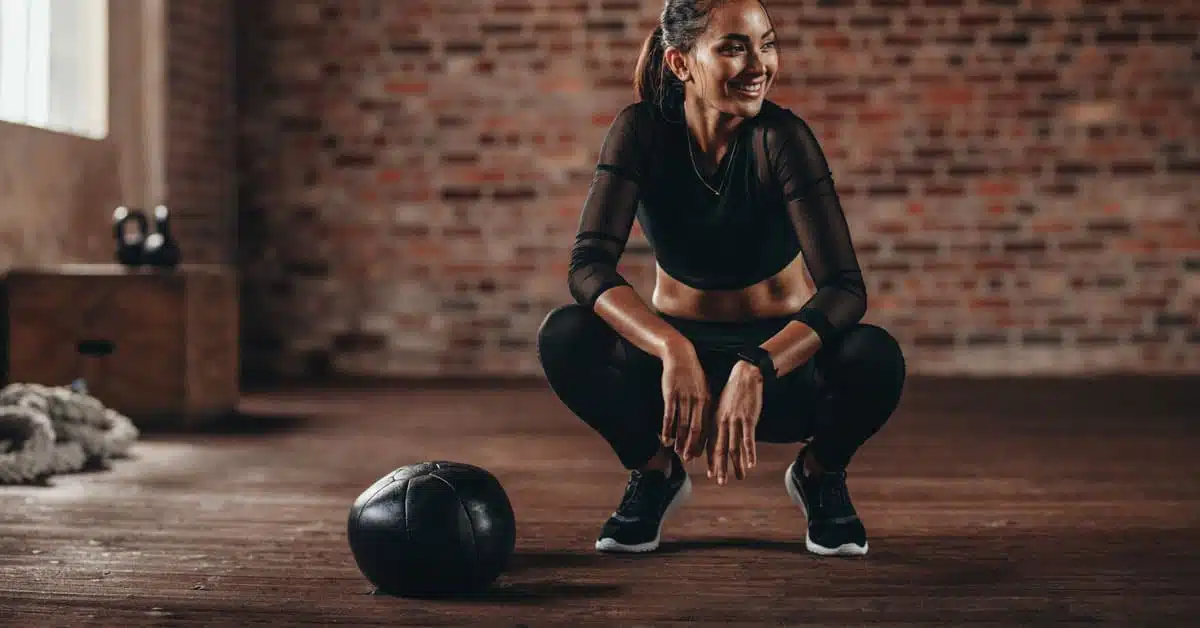As athletes, we worry about quite a few things. Whether it's the right protein supply, the optimization of growth hormone concentrations in the blood, or the optimal tuning of load intervals for maximum adaptive stimulus in training. The life of an athlete is complex. In this context, it is all too easy for seemingly self-evident things to fall by the wayside.
One of these points is the correct BreathingThis is a process that runs so automatically in our lives that we are not even aware of it. And that has consequences, because if you breathe incorrectly during sports, you don't have to be surprised that your own performance doesn't go uphill - this is especially true for endurance athletes, but also for strength athletes.
How does breathing work?
Have you ever really had to consciously think about active breathing? In most cases not, because our body usually does it all by itself. This automatism is controlled by a reflex that, roughly speaking, is activated when the concentration of air containing carbon dioxide becomes too high. When this point is reached, we automatically exhale.
Shortly thereafter, fresh oxygen-rich air flows through the nose and mouth into the lungs when inhaled, where it is released via the finely branched bronchi and the alveoli into hair-thin capillaries as part of the gas exchange process and thus reaches every cell in the body via the bloodstream. In parallel, CO2 is excreted from the blood and leaves the body via the same route.
In principle, we have the option of mouth breathing and nasal breathing, which has some advantages. Nasal breathing is sufficient most of the time to supply us with sufficient oxygen. However, if our body is required to perform at a higher level, we also need larger amounts of oxygen. This is where mouth breathing comes in, which in itself is sufficient to supply us with the necessary oxygen during sports.
Strictly speaking, we wouldn't even need our nose to breathe. Nevertheless, it is indispensable because it performs an essential filtering function and thus protects us from germs and pathogens. And the built-in filter is also extremely practical during sports. Every runner or cyclist who has ever enjoyed an involuntary winged protein snack at higher speeds while breathing through the mouth knows this.
Why nothing works in sports without proper breathing
After all, if the whole thing is automatic, why do I have to worry about my breathing at all? The answer is obvious. If you optimize your breathing technique during sports, you also optimize your physical performance. The better the muscles and internal organs are supplied with oxygen, the more efficiently carbohydrates and fats can be converted into energy in the mitochondria.
While the breathing rate at rest can be taken over by your body's automatism without any problems, the situation is somewhat different under athletic stress. Here, the breathing rate increases significantly from about 14 to 16 breaths per minute. To breathe in as much oxygen as possible, however, it is not enough to simply breathe quickly. This often results in shallow panting, with only imperceptibly more oxygen reaching the lungs.
Much more important is the training of the correct breathing technique for the formation of the respiratory musculature. The stronger the respiratory muscles are, the more oxygen can be absorbed into the body through increased lung capacity, even under maximum loads. If you want to perform, this is enormously important, because especially for endurance performance your body depends on a good energy supply within the aerobic-alactacid energy production mechanism.
If, on the other hand, oxygen is lacking, lactate accumulates in the muscles due to the incomplete metabolization of energy sources. The result: the colloquial "sour legs" and a significant drop in performance. If, on the other hand, you also train your breathing, you prevent the muscles from becoming over-acidified too early.
Abdominal Breathing vs. Chest Breathing - Which is Better?
Even if we don't necessarily notice it, we breathe in two different ways. On the one hand, with the help of so-called chest breathing, and on the other hand, with abdominal breathing. Interestingly, the body does everything right when we are at rest, preferring abdominal breathing when we are relaxed. Due to the involvement of the diaphragm in its role as the most important breathing muscle, this is how the most oxygen reaches the body.
Interestingly, most athletes who do not pay attention to their breathing technique during sports switch to chest breathing under stress. This is a big mistake, especially in stressful athletic situations, because chest breathing is significantly shallower than abdominal breathing and causes us to tire more quickly. This is due on the one hand to the smaller breathing volume and on the other hand to the fact that the diaphragm hardly works at all. It is replaced by the auxiliary breathing muscles, which now have to do almost all the work.
One of the all too familiar consequences is the unpleasant side stitch or the nasty muscle ache between the ribs the following day after a long endurance session. What does this tell us? Correct, as athletes we should consciously focus on training abdominal breathing. To do this, first and foremost, we need to strengthen the respiratory muscles. The following exercises can help you with this:
1. breathe underwater
If you want to train your diaphragm like a normal muscle, you have to create a resistance against which it has to fight. Water is an ideal element for respiratory training here, because even when swimming close to the surface of the water, there is additional pressure on your upper body. So if you go swimming regularly, you're not only doing something for your general fitness, but also for your respiratory muscles.
The rule of thumb here is: the further your upper body is underwater, the more strenuous it is for your breathing muscles. To increase the level of difficulty, stand in a pool with as long a snorkel as possible and squat down until the snorkel is just barely sticking out of the water. Now try to inhale and exhale vigorously. After a few weeks you will notice how much your breathing has improved outside the water.
2. diaphragm training with additional weight
Of course, not everyone has a swimming pool for breathing exercises around the corner, so you can strengthen your breathing muscles for proper abdominal breathing without water. To do this, lie flat on your back on the floor and place some books on your upper abdomen. Now breathe in and out as deeply as you can for 3 to 5 minutes. Even if it takes a little longer until you notice the "training effect", you will already achieve noticeable results after four to six weeks.
3. deep inhalation and exhalation
Optimizing your breathing technique is a good gap filler for everyday life. Of course, you can't lie down on the floor in the office with a stack of books, so you simply resort to deep inhaling and exhaling here. Whether you're on the bus, in your office chair, or in the car, breathing for 6 to 8 minutes twice a day is always worthwhile.
4. oxygen deficiency training
The so-called oxygen deprivation training is a very efficient but also enormously strenuous variant to train the respiratory muscles. The idea here is that you restrict the oxygen supply during regular endurance training so that your respiratory muscles are forced to do more work to get the same amount of oxygen.
For this purpose, you can use a conventional dust mask from the hardware store, for example, which allows significantly less oxygen to pass through due to its filter function. This means that your respiratory muscles have to apply more "suction" in order to absorb an adequate amount of oxygen. Since it admittedly looks strange to sit on the bike or jog a lap in the park with a dust protection mask, you can of course also perform this oxygen deficiency training on the ergometer.
Since this is a particularly challenging training method, it is recommended to use it only as a block training within the framework of 4 to 6 weeks with 2 to 3 units per week. Positive side effect: With this form of training, you not only strengthen your respiratory muscles, but also teach your body to achieve the same performance with less oxygen.
How to breathe correctly during sports
In conclusion, we would like to look at some sports where you can get more performance out of your body with the help of strong breathing muscles and the right breathing technique.
1. running
Most runners match their breathing rate to the cadence or beats of the music while running. If you are one of these athletes, you should stop this as soon as possible, because the frequency is much too fast, resulting in shallow chest breathing with too little oxygen inflow. Take regular deep breaths in and out of your abdomen. This will provide your body with as much oxygen as possible and prevent side stitching.
2. cycling
Shallow breathing is also problematic in cycling. Newcomers, for example, who get on a racing bike for the first time, often suffer from limited performance due to a lack of oxygen. The cause is the strongly forward bent posture in combination with unconscious breathing. Therefore, you should definitely strengthen your breathing muscles and initially start with a slightly more upright riding position, so that your breathing muscles can get used to the upper body curvature.
If, on the other hand, the climb is steep, you can switch to a more upright position on both the mountain bike and the road bike and thus facilitate the oxygen supply. On the mountain, aerodynamics play a negligible role anyway.
3. swimming
While breathing is relatively uncomplicated in breaststroke, since you can breathe at any time, it's a different story in crawl. It is important here that you train yourself a fixed breathing rhythm, which you reel off like an automatism. The two-breath rhythm is best suited here.
This means that you inhale on a set side every second crawl. Compared to the triple rhythm common among many amateur swimmers, this technique is not only easier to learn, but also more efficient. Especially if you are looking for performance, this reduces the risk of driving your body into oxygen debt.
4. strength training
Breathing doesn't matter in strength training? No, not at all. Many strength athletes tend to hold their breath at the moment of maximum exertion, which massively increases both the pressure on the vessels and the pressure on the lungs and heart. It is obvious that this cannot be healthy. The same applies to the widespread press breathing, in which only a little oxygen reaches the bloodstream due to shallow breathing.
The result: loss of performance. Strength training in particular lends itself to regular and deep inhalation and exhalation, as breathing can be perfectly synchronized with movement. The simple rule here is to exhale during the load and inhale during the unload phase.




